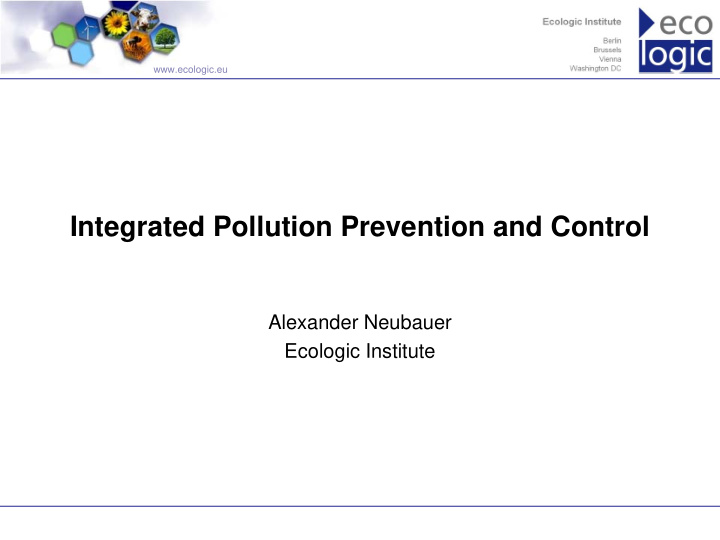



www.ecologic.eu Integrated Pollution Prevention and Control Alexander Neubauer Ecologic Institute
www.ecologic.eu Table of content Main European Legislation Permit Requirements Best Available Technologies (BAT) BREFs New legislation 2
www.ecologic.eu Main European legislation Traditionally different pieces of legislation on industrial emissions Sectoral directives constituting minumum requirements (e.g. Large Combustion Plant Directive, Waste Incineration Directive) Horizontal directive Directive on Integrated Pollution Prevention and Control (IPPC Directive) laying down the use of Best Available Techniques as basis for the permits for a range of specific types of industrial installations In 2010 different sectoral directives and the IPPC Directive were merged into one Industrial Emissions Directive 3
www.ecologic.eu Permit Requirements Core requirements of the IPPC Directive are that industrial installations covered by Annex I of the Directive be permitted the integrated permits be based on Best Available Techniques In 2007: 52,000 installations across all EU Member States fell within the remit of the IPPC Directive The permits need to be integrated permits, i.e. have to cover all relevant environmental issues (such as emissions into air, water, soil; waste management, efficient use of energy and accident prevention) 4
www.ecologic.eu Scope of current IPPC Directive Annex I enumerates the types of installations covered by the Directive and at times sets thresholds for installations (e.g. capacity) which distinguish IPPC installations from non-IPPC Installations Installations covered by the IPPC Directive concern the following activities Energy Industries Production and processing of metals Mineral industry 5
www.ecologic.eu Scope of current IPPC Directive Chemical Industry Waste Management Others (e.g. specific agricultural installations 6
www.ecologic.eu Permits based on BAT Permit conditions including emission limit values in IPPC permits must be based on Best Available Techniques (BAT) without prescribing the use of any technique or specific technology Definition of BAT (see Art. 2(12) IPPC Directive): most effective and advanced stage in the development of activities and their methods of operation which indicates the practical suitability of particular techniques for providing the basis for emission limit values and other permit conditions designed to prevent and, where that is not practicable, to reduce emissions and the impact on the environment as a whole 7
www.ecologic.eu Concept and Role of BREFs Primary source to identify BAT for the different types of installations are B est Available Techniques Ref erence Documents ( BREFs ) BREFs exist for different types of installations, e.g. BREF on Waste Incineration, Cement&Lime BREF, etc. are the result of an exchange of information between experts from EU Member States BREFs are published and adopted by EU Commission are updated on a regular basis 8
www.ecologic.eu Concept and Role of BREFs BREFs describe the Best Available Techniques in the EU for the different types of installation, inter alia presenting emissions and consumption levels associated with these techniques The information contained in the BREFs has to be translated by the licensing authorities on the ground into concrete permit conditions for the specific installation Some countries lay down general binding rules (e.g. laws/ordinances) based on the BREFs featuring specific emission limit values these rules might need to be updated when BREFs are updated 9
www.ecologic.eu New Directive on Industrial emissions In November 2010 the new Directive on Industrial Emissions was adopted that merged the following directives into one directive: the Large Combustion Plant Directive (LCPD); the Integrated Pollution Prevention and Control Directive ( IPPCD); the Waste Incineration Directive (WID); the Solvent Emissions Directive (SED); and the three existing directives on Titanium dioxide on (i) disposal (78/176/EEC), (ii) monitoring and surveillance ( 82/883/EEC) and (iii) programs for the reduction of pollution (92/112/EEC). 10
www.ecologic.eu New Directive on Industrial emissions (some new provisions) The role of the BREFs is emphasised and the process of their elaboration is clearly described Specific conditions are laid down if BREFs (“BAT conclusions”) are not used when permit conditions are developed Directive includes minimum emission limit values for the types of installations once governed by the sectoral directives now included in the Directive on Industrial emissions Revised minimum emission limit values for Large Combustion Plants 11
www.ecologic.eu New Directive on Industrial emissions (some new provisions) Precise rules for planning inspections of installations The Directive on Industrial Emissions is due to be transposed into national legislation by Member States by 7 January 2013. 12
www.ecologic.eu Links http://prtr.ec.europa.eu/ http://eippcb.jrc.es/ 13
www.ecologic.eu Thank you for listening. Alexander Neubauer Ecologic Institute, Pfalzburger Str. 43-44, D-10717 Berlin Tel. +49 (30) 86880-0, Fax +49 (30) 86880-100 Alexander.neubauer@ecologic.eu www.ecologic.eu 14
Recommend
More recommend